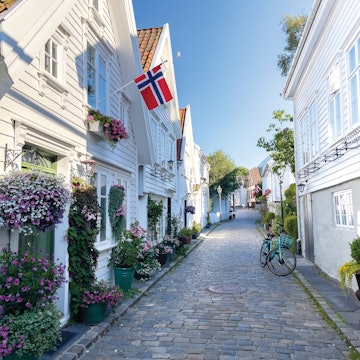

Bakklandet neighborhood in Trondheim, Norway. Nina Alizada/Shutterstock
Norway is known for its spectacular landscapes and, because it's one of the most beautiful countries on the planet, there's no such thing as a bad time to visit.
However, certain seasons will affect the many big attractions and experiences on offer – prioritizing what you want to do, where you want to go, and understanding seasonal differences will be key to planning your trip.
Summer is the most popular time to visit: it has the best weather and long hours of daylight, prices are generally cheaper, and everything’s open. Winter is a magical and popular time to visit if you’re on a quest to see the northern lights. And for those looking to follow their own path along quiet roads to find a Norway stripped of all tourist hype, spring and autumn may be for you.
Here's everything you need to know about picking the best time to visit Norway.

June to August is the best time for good weather and cheaper prices
There is no better time to visit Norway than in summer. Let’s start with the weather. This being a Scandinavian country with much of its territory within the Arctic Circle, no one can guarantee sunshine every single day, but from June to August, clear, mild days with a piercing blue sky are the norm. This is the best time to see the fjords, the Lofoten Islands or Svalbard at their most pristine and glorious.
Summer days here seem to last forever: north of the Arctic Circle, there is at least 1 day every year when the sun never sets. The further north you go, the more of these days you get. Even in Norway’s south, there’s no such thing as complete darkness throughout summer as the sun’s light from just below the horizon bathes the night hours in a sepulchral glow.
Summer is, of course, high season in Norway. This can mean that everything – from all roads and campgrounds to tourist attractions like boat cruises on the fjords – gets busy. This is also when most of the festivals happen, and when the majority of locals take to the roads. But traveling at this time comes with an unexpected bonus: unlike high seasons just about everywhere else, high season in Norway means cheaper accommodation prices. While this may sound counterintuitive, the reason is simple: Norway is one of the most expensive countries on earth, and the only people traveling at other times are business travelers on expense accounts. In other words, prices drop so that tourists can afford to travel.
There is one further advantage to traveling in Norway in the summer. For much of the year, Norway’s wild landscapes are susceptible to the kind of unpredictable weather you just don’t want to get caught up in. With that in mind, the hiking season only runs for the 3 summer months every year. It’s also the best (and, in some cases, the only) time for cycling, white water rafting and whale-watching off the coast of Vesterålen.

December to February is the best time for the northern lights
Summer may open up a whole world of possibilities but the Norwegian winter has a special (and increasingly popular) call all its own. This is the time of year when the northern lights dance across the sky in great curtains and cascades of shape-shifting colored light. Truly one of the natural world’s greatest spectacles, the aurora borealis happens year-round, but Norway’s long winter nights provide the perfect conditions in which to see them.
Yes, you need clear skies, which is never something that can be guaranteed in the depths of a Norwegian winter. And you never quite know when or where they’re going to appear. But when they do, it’s the kind of experience that lingers in your memory with all of the magic of a fairy tale coming to life.
Winter is also when the polar night descends upon the country, casting it into darkness for months at a time; the sun doesn’t even appear above the horizon from late October to mid-February in Svalbard’s Longyearbyen. But seeing the country at this perspective-altering time can be almost as memorable as seeing the northern lights. If you’re lucky, you’ll experience both.
When the sun is shining in winter, as it does surprisingly often wherever daylight occurs, the snows that cover much of the country transform Norway into a land of singular and spectacular beauty. Even in the iciest conditions, most of Norway’s roads remain open throughout winter, and elsewhere Norwegians take to the paths – whether to the local shops or out into the wilderness – on cross-country skis. If you’re not inclined to join them, there’s always dog-sledding, ice hotels and snowmobiling for those looking to immerse themselves in Norway’s frozen winter world.

March to May and September to November are the best times for quiet roads
With so much going on in summer and winter, Norway falls relatively quiet during the spring and fall months. And therein lies the appeal of visiting at this time. Beyond city limits, Norway’s roads are quieter by a near-exponential magnitude. It’s also easier to come by your favorite hotel booking, while weekend accommodation prices can be the same as those seen otherwise only in summer.
If you time your visit right and visit in late spring (May, for example) or early autumn (September), you might also enjoy some of the benefits of summer – cheaper hotels, hiking trails still open – but without the crowds.
And yet, perhaps the greatest benefit of traveling at this time is something less tangible. In many ways, this is an ideal time to observe Norway, to look through a window into the world of local life as it goes quietly about its business. It can be a far (and deeply satisfying) cry from the world of busy tourist attractions and carefree summer months.















